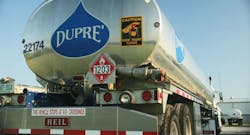Paying by the Mile Caused Fatigue, Crashes and Fatalities
"We were compliant, and we were legal, but we weren’t safe," says Reggie Dupré, the company's Chief Executive Officer. "We were having serious accidents, fatalities, and we had to figure out what was going on with our business. We decided to change the way we scheduled our drivers and limit their time, because they were fatigued which was causing the fatalities."
The Lafayette, Louisiana-based fleet, founded in 1980 as a tank truck hauler, elected to change driver scheduling and reduce their time. "We went to a schedule of around 50 to 55 hours a week, 5 days a week. Drivers work five-two, five-three schedules; they get off two days one week and three days another week."
In order to make this new model work, they had to pay drivers by the hour instead of the by the mile, which was, and still is, the industry norm. "Paying by the hour seemed the fair thing to do, Dupré adds. "We didn't want them to lose any money from what they were making before, so we decided to pay them by the hour. We eventually realized that paying them by the mile, or paying them a percentage of revenue, was actually causing unsafe behavior.
"We went to a pay-per-hour scheme about 15 years ago for two main reasons, explains Dupré. "We did it to improve safe operation, and we did it to create what we call the 'ideal place to work.'" Dupré Logistics is one of the safest fleets in the industry if the awards they receive are any indication including winning the American Trucking Associations' President’s Trophy Award for safety twice in the past four years in the 25 to 100 million mile category. They have received other regional, state and national safety awards, too.
"The drivers at that time, in our business, were soaking up all the inefficiencies. They were shouldering all the inefficiencies of our industry, of the highways, of our dispatch, of our maintenance, everything. They were paid by the piece, so if anything stopped them or slowed them down they were bearing the burden."
The company took on those burdens. "The inefficiencies that neither of us could manage we chose to manage for them. This included highway construction, accidents, waiting in line to get loaded, those kinds of things. We said, 'We’ll take care of that now.'"
There was an additional cost, however, but not necessarily in money. Managing the model was difficult and it altered the relationship between company and driver. "We said that we're not going to let you just goof off and do what you want to do. We're going to manage your behavior and we expect you to manage your behavior, too."
The company guarantees 40 hours minimum work and overtime after that. "We pay all of our drivers hourly - over-the-road drivers, local drivers - everybody gets paid an hourly rate."
Paying by the hour also helped their retention rate, Dupré says. "Our retention rate back then was about 75 percent, and the industry was running north of 100 percent. To make Dupré the 'ideal place to work,' we looked at the characteristics of all companies rated best to work for, not only in the trucking industry, but in other industries around the world. We wanted to learn what made these companies a desirable workplace."
The company incorporated these characteristics, which turned into overarching principles for their business which now includes Site & Private Fleet Services, Strategic Capacity Services and Energy Distribution Services.
"We wanted to create a job that was sustainable where a person could have a family life, a person would know when they were going to be off, and a guarantee that they would be paid a certain amount. We wanted to stabilize their income," says Dupré.
"It worked. Back then our turnover was 75 percent and right now it's running around 17 percent, and we’ve got about 1200 drivers and 600 trucks."
Better morale was also a positive effect. "The company regularly surveys their workforce and the drivers always say: 'The best thing about Dupré is hourly pay,'" he notes. "The drivers feel that we're on their side."
Managing Hourly Pay is Like Juggling
Dupré says that an hourly pay scheme requires additional skills. "You have to be expert at time-in-motion management. You have to be good coaches to make sure your drivers feel like they’re being helped but not being watched over their shoulders. You’ve got independent people running out there and not supervised, and you have to find a way to manage them. It’s difficult."
And that's why Dupré doesn't advocate pay per hour for every fleet even though it's worked for them. "It’s hard to manage, and I think that’s why people haven’t gone to it. There are some very good companies out there that are managing their businesses, that are producing safe operations, good profits and growing their business, but they may be struggling with turnover and there’s a high cost to that."
Dupré often is asked to speak about his company's policies and has noticed that very few fleet managers or owners ask him about hourly pay. "They don't want to go there. I get it; it’s very, very difficult. This business is like juggling. You've got to manage the service you give to customers, the safe operation that you produce on the highways and for your drivers and society in general -- and the profitability of the company. You’re juggling all that, and if you’re doing a good job and you’re hitting those parameters and you do it with a certain business model then you don’t want to take another ball [hourly pay] that’s harder to juggle."
He doesn't chide other fleets for their way of doing business. "They don't want to take on another task, another risk, and I understand that. I respect that. They may make more money than we do, maybe, but they’re not as safe, and they don’t have a better retention level. We just have to figure out how to get paid for the value we create, and we’re working on that. We’re doing good."
As for the future, Dupré says that other fleets will continue to experiment with how they pay drivers in order to increase safety, reduce turnover and attract new drivers. "Over the next five years, because of demographic changes, the aging of the drivers, the economy coming out of the recession, and regulations and compliance issues that are going to take capacity out of the current driving force, the driver issue is going be more critical… We're going to see fleets try different things. Personally, I think we're going to see someone pay drivers a salary, manage the time and completely stabilize a driver’s earnings. We're going to see more innovative ideas being tried, even more innovative than Dupré. We're going to keep our eyes open for the next good thing."
About the Author

Larry Kahaner
Larry Kahaner is an author, journalist, and former FleetOwner contributor.
